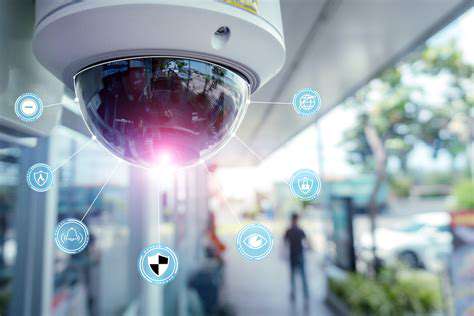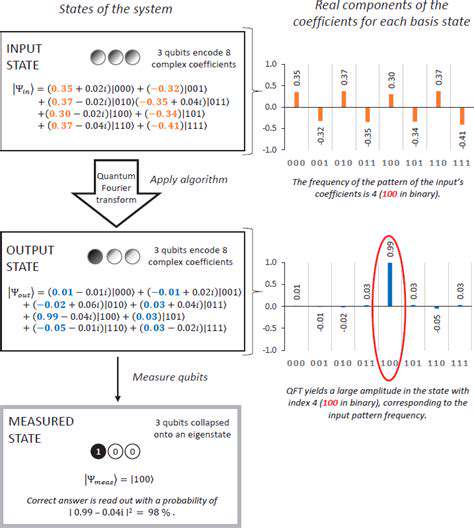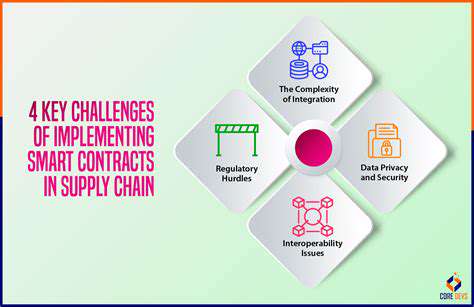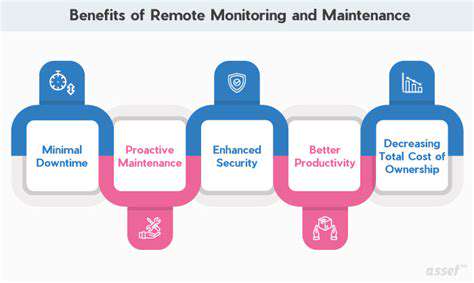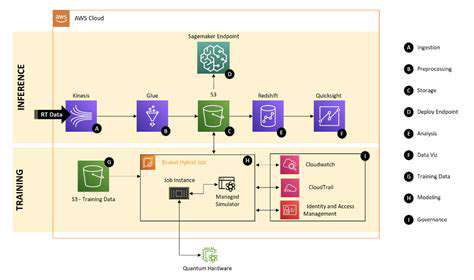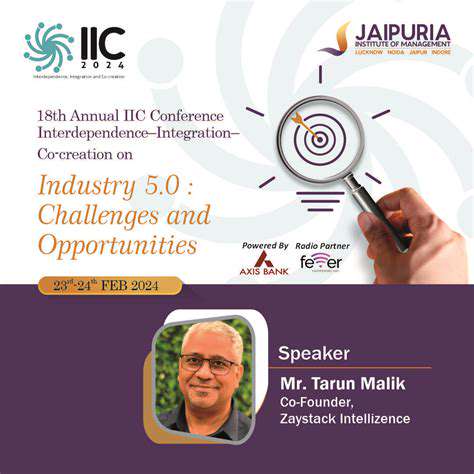Beyond the Limits of Classical Sensors
Quantum Sensors: A Paradigm Shift in Measurement
Quantum sensors leverage the principles of quantum mechanics to achieve unprecedented levels of precision in measurement. Unlike classical sensors, which rely on macroscopic physical phenomena, quantum sensors utilize the subtle properties of quantum systems, like superposition and entanglement, to detect extremely minute changes in physical parameters. This fundamentally different approach opens up new possibilities for advancing scientific discovery and technological innovation.
This shift from classical to quantum sensing allows for the detection of signals that were previously undetectable, enabling applications in fields ranging from fundamental physics to medical diagnostics. The enhanced sensitivity and specificity of quantum sensors have the potential to revolutionize various sectors, offering a significant leap forward in precision measurement.
Superconducting Circuits: A Quantum Leap in Sensing
Superconducting circuits are a prominent platform for quantum sensing, offering a promising pathway to highly sensitive detectors. These circuits exploit the unique properties of superconductors, such as their ability to maintain a zero electrical resistance, to achieve exceptional sensitivity in measuring magnetic fields, electric fields, and even gravitational forces. The delicate manipulation of these circuits allows for precise control over quantum states, leading to enhanced measurement precision.
Atomic Clocks: Unprecedented Temporal Accuracy
Atomic clocks, utilizing the precise energy levels of atoms, represent a pinnacle of temporal accuracy. Quantum sensors based on atomic clocks achieve extraordinary stability and precision in measuring time, far exceeding the capabilities of traditional timekeeping methods. These advancements have profound implications for GPS technology, navigation, and fundamental research in fields like cosmology.
Quantum Entanglement: Enhanced Sensitivity
Entanglement, a cornerstone of quantum mechanics, plays a crucial role in enhancing the sensitivity of quantum sensors. By entangling two or more quantum systems, a measurement on one system instantaneously affects the other, regardless of the distance separating them. This correlation allows for a significant improvement in the signal-to-noise ratio, enabling precise measurements in challenging environments or with subtle signals.
Quantum Dots: Precision in Nanoscale Environments
Quantum dots, semiconductor nanocrystals, offer unique opportunities for quantum sensing at the nanoscale. Their discrete energy levels and tunable properties allow for the detection of minute changes in their environment, such as electric and magnetic fields. This precision at the nanoscale opens doors for applications in biomedical imaging, material science, and environmental monitoring.
Photonics: Light-Based Quantum Sensing
Photonics, the science of light, provides a powerful tool for quantum sensing. Manipulating photons, the fundamental particles of light, through quantum optical techniques allows for the measurement of various physical phenomena. This approach is particularly advantageous for sensing applications requiring high speed, remote detection, or compatibility with existing optical infrastructure. The sensitivity of these systems can be further enhanced through intricate manipulations of light-matter interactions.
Quantum Sensing Applications: Revolutionizing Diverse Fields
Quantum sensing is poised to revolutionize a wide range of fields. From improving navigation and communication systems to enabling novel medical imaging techniques and pushing the boundaries of fundamental physics research, the potential applications are vast and transformative. The development and implementation of quantum sensors are paving the way for a new era of precision measurement, impacting areas from environmental monitoring and materials science to astronomy and beyond.
Key Quantum Sensing Mechanisms: Exploring the Possibilities

Quantum Sensing Mechanisms: Superconducting Circuits
Superconducting circuits, a cornerstone of quantum sensing, leverage the delicate interplay of quantum mechanics and electrical engineering. These circuits are designed to be highly sensitive to changes in their environment, primarily through the manipulation of superconducting qubits. These qubits are extremely sensitive to fluctuations in magnetic fields, electric fields, and even temperature variations. By carefully controlling the state of these qubits and measuring their response, scientists can detect incredibly minute changes in the surrounding environment. This sensitivity is crucial for applications ranging from medical imaging to fundamental physics research.
One key mechanism involves exploiting the Josephson effect, where superconducting materials exhibit a quantum tunneling phenomenon. Variations in the external environment, such as changes in magnetic fields, directly impact the Josephson junction's energy levels, leading to measurable changes in the circuit's properties. These changes are precisely what quantum sensors detect and translate into valuable information. The precise control and manipulation of these circuits allow for an unprecedented level of sensitivity and accuracy in measuring physical phenomena.
The development of advanced fabrication techniques and materials science plays a critical role in achieving the required sensitivity and stability. The integration of these circuits with other quantum technologies, such as quantum computing, opens up new avenues for future discoveries. The potential for enhanced precision and speed in scientific measurements is significant.
Quantum Sensing Mechanisms: Atomic Clocks
Atomic clocks, relying on the precise oscillations of atoms, represent another powerful quantum sensing mechanism. These clocks utilize the inherent quantum properties of atoms to achieve unparalleled accuracy and stability in measuring time. The transitions between energy levels in atoms are extremely precise and predictable, making them ideal for sensing subtle changes in the environment. This precision is fundamentally a quantum effect.
The sensitivity of atomic clocks stems from their ability to detect minute shifts in the frequency of atomic transitions. These shifts can be caused by a wide array of external factors, including variations in temperature, pressure, and gravitational fields. By precisely measuring these shifts, atomic clocks can provide valuable data on these environmental changes. This sensitivity makes atomic clocks invaluable tools in various fields, from geophysics to space exploration.
One critical aspect of using atomic clocks for sensing involves the development of advanced optical technologies for trapping and manipulating atoms. The ability to precisely control and measure the atoms' environment is essential for realizing the full potential of these quantum sensors. Furthermore, the integration of atomic clocks with other quantum sensors promises to revolutionize numerous scientific and technological applications.
Applications Across Diverse Industries

Automation in Manufacturing
Manufacturing industries are increasingly leveraging automation to streamline production processes, enhance efficiency, and reduce operational costs. Automated systems can perform repetitive tasks with precision and speed, minimizing human error and maximizing output. This translates to significant improvements in productivity and quality control. Automated assembly lines, robotic arms for welding and painting, and automated material handling systems are common examples of this trend. These technologies are also crucial in adapting to changing market demands and production volumes.
Furthermore, automation allows for greater flexibility in production, enabling manufacturers to respond quickly to changes in customer orders or product specifications. The integration of advanced sensors and data analytics further enhances the decision-making process, enabling proactive maintenance and predictive modeling for optimized resource allocation.
Optimization in Supply Chain Management
Supply chain management is undergoing a transformation driven by automation and data analysis. Sophisticated software solutions are enabling real-time tracking of goods and materials, reducing bottlenecks and ensuring timely delivery. This improved visibility across the supply chain enhances responsiveness to market fluctuations and disruptions. The ability to predict demand patterns and proactively adjust inventory levels significantly reduces costs and waste.
By integrating data from various sources, such as transportation providers, warehouses, and retailers, businesses gain a holistic view of their supply chain. This comprehensive understanding allows for smarter decisions regarding inventory control, transportation logistics, and warehouse operations. Ultimately, this optimization leads to increased efficiency, reduced costs, and enhanced customer satisfaction.
Enhanced Customer Experience in Retail
The retail sector is embracing automation to create a more personalized and efficient customer experience. From self-checkout kiosks to automated inventory management systems, retailers are leveraging technology to improve the speed and accuracy of transactions. This streamlined process reduces wait times for customers and enhances overall satisfaction. The use of data analytics allows retailers to understand customer preferences and tailor their offerings accordingly, leading to increased sales and customer loyalty.
Healthcare and Medical Advancements
Automation is playing an increasingly vital role in healthcare, from robotic surgery to automated diagnostics. The use of robotic systems in surgery allows for greater precision and reduces invasiveness. This leads to faster recovery times and reduced complications. Automated diagnostic tools can analyze medical images and patient data to identify potential issues, enabling quicker interventions and improving treatment outcomes.
Furthermore, automation in healthcare administration, such as appointment scheduling and claims processing, streamlines workflows, reduces administrative burdens, and frees up valuable time for medical professionals to focus on patient care. The integration of these technologies fosters efficiency and enhances the overall quality of healthcare services.
Challenges and Future Outlook
Technological Hurdles
Quantum sensors, while promising revolutionary advancements in precision measurement, face significant technological hurdles. One key challenge lies in the delicate nature of quantum systems. These systems are extremely susceptible to environmental noise and disturbances, which can easily disrupt the precise measurements they are designed to perform. Maintaining the extreme sensitivity and coherence of quantum states often requires sophisticated isolation and control mechanisms, adding complexity and cost to the development and deployment of these technologies.
Furthermore, the fabrication and integration of quantum sensors with existing infrastructure presents another significant hurdle. Developing reliable and scalable manufacturing processes for quantum components is crucial for widespread adoption. Moreover, integrating these sensors into existing measurement systems and protocols requires careful engineering considerations, which can be challenging and time-consuming. The technical expertise needed to design, build, and maintain these sophisticated devices is also a limiting factor that needs significant investment.
Cost and Scalability Concerns
The high cost of materials, fabrication processes, and specialized equipment required for quantum sensor development is a major barrier to widespread adoption. The current manufacturing methods often involve intricate procedures and materials that are not readily available or affordable, leading to high production costs. This makes quantum sensors inaccessible to many potential users, particularly in resource-constrained environments. Overcoming these cost barriers is essential for making these technologies more widely available.
Achieving scalability in quantum sensor production is another critical challenge. Currently, the production of quantum sensors is often limited by the ability to create consistent and reliable devices. Scaling up production to meet the demands of various applications requires developing efficient and cost-effective manufacturing processes. This includes optimizing fabrication techniques and creating high-throughput methods for producing the needed components. Increased research and development in this area is essential for the future of quantum sensing.
Applications and Integration
While the potential applications of quantum sensors are vast, their integration into existing systems and workflows is a complex undertaking. The unique characteristics of quantum sensors, such as their sensitivity and precision, often require significant modifications to existing measurement standards and protocols. Furthermore, adapting existing infrastructure to accommodate these new technologies can be expensive and time-consuming. Careful consideration must be given to the compatibility of quantum sensors with existing instruments and data analysis pipelines to ensure seamless integration.
Exploring new applications and integrating quantum sensors into different fields, like medicine, material science, or geophysics, requires further research and development. This includes investigating the specific needs and challenges of each application to tailor the sensor design and functionality. Developing user-friendly interfaces and data analysis tools for these sensors is also crucial for widespread adoption and practical applications in various industries.
Addressing Environmental Factors
Maintaining the stability and coherence of quantum systems is paramount for accurate measurements. Quantum sensors are highly susceptible to environmental factors such as temperature fluctuations, vibrations, and electromagnetic fields. Developing robust shielding and control mechanisms to mitigate these disturbances is essential for achieving the desired level of precision. Minimizing the impact of the surrounding environment on the quantum sensor's performance is a critical aspect of sensor design and operation.
